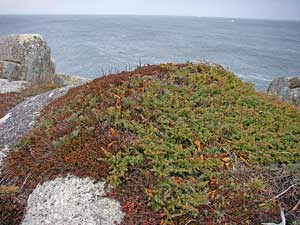Ericaceae: Empetrum eamesii Fern. & Wieg.
(rockberry, red-fruited crowberry, purple crowberry, pink crowberry)
Empetrum eamesii is one of three crowberries in Nova Scotia; others are Empetrum nigrum (black crowberry) and Corema conradii (broomcrowberry).1, 2 They are low, evergreen shrubs with small, needle-like ericoid leaves and reduced, wind-pollinated flowers which open in spring. Empetrum eamesii is the less common of the two species of Empetrum in Nova Scotia. Both bear solitary or a few flowers in axils of leaves (versus terminal flowers in C. conradii). The white, tomentose (hairy) young branchlets of E. eamesii distinguish it from E. nigrum (not tomentose).  Two subspecies are currently recognized:
Two subspecies are currently recognized: - E eamesii ssp. atropurpureum (purple crowberry) with dark red or purple fruits
- E eamesii ssp. eamesii (rock crowberry, pink crowberry) with light brown, pink or red fruit.
(Fruits are black in E. nigrum.) Hybrids are found between the subspecies, also between E. eamesiii and E. nigrum. E. eamesii ssp. atropurpureum is found on "exposed sand dunes, infrequently around bogs, and occasionally in rocky habitats", while E eamesii ssp. eamesii is reported to be "characteristics of exposed headlands on top of lichen-bearing rocks with thin soil."3 Both subspecies appear to have limited distributions in N.S.: both occur in northern Cape Breton, and on the Chebucto peninsula; E. eamesii ssp. eamesii has also been reported from the Canso area. 3. E. eamesii ssp. atropurpureum occurs in all provinces of Atlantic Canada, and in Qubec, northern New England, northern New York, Michigan Minnesota, Ontario and Saskatchewan; E. eamesii ssp. eamesii is restricted to Quebec, N.S., P.E.I.2 and Labrador & Newfoundland.4 E. eamesii is yellow listed (sensitive) under the Nova Scotia DNR General Status Rankings.
Sources | Notes & Refs | Selected Web Resources
Click on images for larger versions.
|
April 28, 2009. Chebucto Head Photographer: JackPine. | |
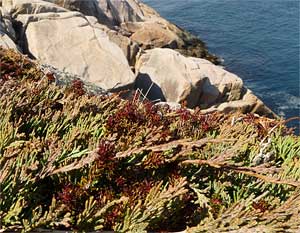 Flowering male plants amongst J. horizontalis | 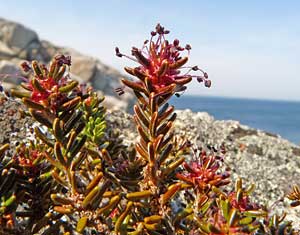
|
 |
Patch of female plants (the greener patch in the middle).
Patches of male plants were common and had abundant flowers; female patches were much less common and had fewer flowering plants. |
 Flowering female plants |
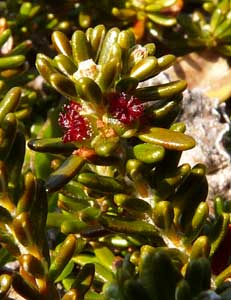
|
|
July 5, 2008. Chebucto Head Photographer: JackPine. Notes |
|

Barrens habitat. |
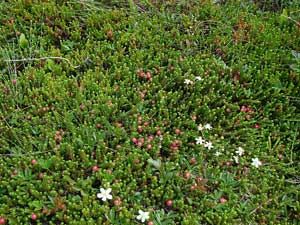 E. eamesii carpet; flowering Potentilla tridentata. |
 |
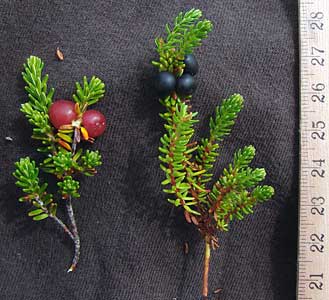 E. eamesii, left; E. nigrum, right: portions of branches with upper surfaces of leaves showing (mostly). |
 As at left: lower surfaces (mostly). |
|
Dec. 2, 2008. Chebucto Head Photographer: JackPine. Notes |
|
 |
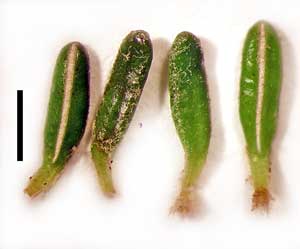
Left: Twigs. Bar is 5 mm. |
 Habitat: E. eamesii occurs amongst Juniperus horizontalis on sloping outcrop by the sea; E. nigrum replaces E. eamesii in the lower lying J. communis. Details. |
 E. eamesii and Junper horizontalis. |
 Abundant flower buds, one (right) opening. |
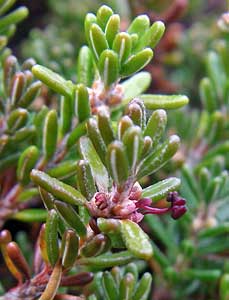 |
 Habitat: A mat of E. eamesii formed the leading edge of vegetation on a large erratic. Details |
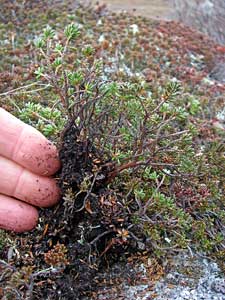 Mat pulled back to illustrate thin humic layer and branching of E. eamesii. |
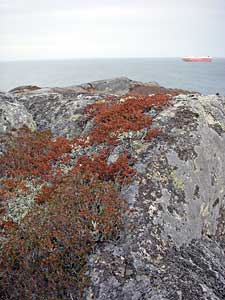 Habitat: On upper part of exposed granite surface; Corema conradii on lower part with no overlap. |
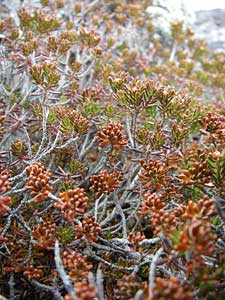 ; ;E. eamesii in foreground, C. conradii in background (looking down the rock slope). |
- Taxonomic Status (ITIS) Copy the species name above and paste it into a form on this ITIS Canada page to confirm the nomenclature and list synonyms.
- NatureServe Explorer Copy the species name above and paste it into a form on this page to view a map of its distribution within North America and its conservation status by province and state.
- A Digital Flora of Newfoundland and Labrador Vascular Plants. Ericaceae: Heath Family ["Empetraceae Section": Crowberries]
Notes & References
- A recent revison of Ericaceae places the crowberries, formerly included in the family Empetraceae, in the family Ericaeae, subfamily Ericoideae, tribe Empetrea. See Kron, K.A. et al. 1992. Phylogenetic classification of Ericaceae: molecular and morphological evidence. The Botanical Review 68(3): 335-423.
- E. rubrum, as cited in the 3rd ed. of Flora of Nova Scotia, is synonymous a with E.eamesii. Southern hemisphere E. rubrum is a separate taxon altogether, see Li, J., et al. 2002. Phylogenetic relationships of Empetraceae inferred from sequences of chloroplast gene matK and nuclear ribosomal DNA ITS region. Molecular Phylogenetics and Evolution 25(2): 306-315.
- Roland, A.E., Zinck, M. and Owen, E. 1998. Roland's Flora of Nova Scotia, 3rd Ed. Halifax: Nimbus & Nova Scotia Museum.
- E. eamesii is not indicated to be present in Newfoundland in the NatureServe Explorer listings, however John Maunder documents a number of sites where it occurs; see Digital Flora of Newfoundland and Labrador Vascular Plants. Ericaceae: Heath Family ["Empetraceae Section": Crowberries] (http://www.digitalnaturalhistory.com/flora_empetraceae_index.htm). [Accessed 3 Dec. 2008]
